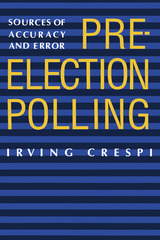2 books about Accuracy

Predicting Species Occurrences
Issues of Accuracy and Scale
Edited by J. Michael Scott, Patricia J. Heglund, and Michael L. Morrison; Foreword by Peter H. Raven
Island Press, 2002
Predictions about where different species are, where they are not, and how they move across a landscape or respond to human activities -- if timber is harvested, for instance, or stream flow altered -- are important aspects of the work of wildlife biologists, land managers, and the agencies and policymakers that govern natural resources. Despite the increased use and importance of model predictions, these predictions are seldom tested and have unknown levels of accuracy.Predicting Species Occurrences addresses those concerns, highlighting for managers and researchers the strengths and weaknesses of current approaches, as well as the magnitude of the research required to improve or test predictions of currently used models. The book is an outgrowth of an international symposium held in October 1999 that brought together scientists and researchers at the forefront of efforts to process information about species at different spatial and temporal scales. It is a comprehensive reference that offers an exhaustive treatment of the subject, with 65 chapters by leading experts from around the world that: review the history of the theory and practice of modeling and present a standard terminology examine temporal and spatial scales in terms of their influence on patterns and processes of species distribution offer detailed discussions of state-of-the-art modeling tools and descriptions of methods for assessing model accuracy discuss how to predict species presence and abundance present examples of how spatially explicit data on demographics can provide important information for managers An introductory chapter by Michael A. Huston examines the ecological context in which predictions of species occurrences are made, and a concluding chapter by John A. Wiens offers an insightful review and synthesis of the topics examined along with guidance for future directions and cautions regarding misuse of models. Other contributors include Michael P. Austin, Barry R. Noon, Alan H. Fielding, Michael Goodchild, Brian A. Maurer, John T. Rotenberry, Paul Angermeier, Pierre R. Vernier, and more than a hundred others.Predicting Species Occurrences offers important new information about many of the topics raised in the seminal volume Wildlife 2000 (University of Wisconsin Press, 1986) and will be the standard reference on this subject for years to come. Its state-of-the-art assessment will play a key role in guiding the continued development and application of tools for making accurate predictions and is an indispensable volume for anyone engaged in species management or conservation.
[more]

Pre-Election Polling
Sources of Accuracy and Error
Irving Crespi
Russell Sage Foundation, 1988
Since 1948, when pollsters unanimously forecast a Dewey victory over Truman, media-sponsored polls have proliferated, accompanied by a growing unease about their accuracy. Pre-Election Polling probes the results of over 430 recent polls and taps the professional "lore" of experienced pollsters to offer a major new assessment of polling practices in the 1980s. In a study of unusual scope and depth, Crespi examines the accuracy of polls conducted before a range of elections, from presidential to local. He incorporates the previously unpublished observations and reflections of pollsters representing national organizations (including Gallup, Roper, and the CBS/New York Times Poll) as well as pollsters from state, academic, and private organizations. Crespi finds potential sources of polling error in such areas as sampling, question wording, anticipating turnout, and accounting for last-minute changes in preference. To these methodological correlates of accuracy he adds important political considerations—is it a primary or general election; what office is being contested; how well known are the candidates; how crystallized are voter attitudes? Polls have become a vital feature of our political process; by exploring their strengths and weaknesses, Pre-Election Polling enhances our ability to predict and understand the complexities of voting behavior. "Combines intelligent empirical analysis with an informed insider's interpretation of the dynamics of the survey research process....Should be studied not only by all practitioners and students of opinion research but by anyone who makes use of polls." —Leo Bogart, Newspaper Advertising Bureau, Inc.
[more]
READERS
Browse our collection.
PUBLISHERS
See BiblioVault's publisher services.
STUDENT SERVICES
Files for college accessibility offices.
UChicago Accessibility Resources
home | accessibility | search | about | contact us
BiblioVault ® 2001 - 2024
The University of Chicago Press









